《大学体育》课程中英文简介
《大学体育(三)》课程教学大纲
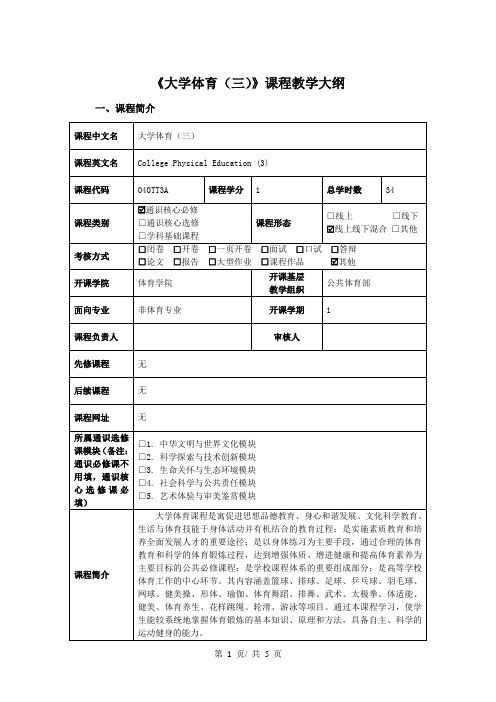
三、课程目标与毕业要求对应关系
表2 课程目标与毕业要求对应关系
课程三维目标
毕业要求目标
本课程目标与毕业要求的对应关系
知识目标
学科知识
√
医学知识
√
通识性知识(自然科学和人文社会科学方面的知识;有关艺术方面的知识;信息技术知识;有关国情的知识,等等)
□论文□报告□大型作业□课程作品其他
开课学院
体育学院
开课基层
教学组织
公共体育部
面向专业
非体育专业
开课学期
1
课程负责人
审核人
先修课程
无
后续课程
无
课程网址
无
所属通识选修课模块(备注:通识必修课不用填,通识核心选修课必填)
□1. 中华文明与世界文化模块
□2. 科学探索与技术创新模块
□3. 生命关怀与生态环境模块
下学期10%
(梅山和植物园校区下学期20%)
游泳成绩
蹬边滑行、自由泳
价值目标
随堂考试
游泳大纲
上学期0%
下学期20%
(梅山和植物园校区0%)
总分
100
随堂考试
大纲
100
附:考核项目详细评分标准见各分项大纲。
八、教学资源
表6 本课程的基本教学资源
资源类型
资源
教材
《大学体育与健康教程》上海交通大学出版社,2016.8,.非外文原版
□4. 社会科学与公共责任模块
□5. 艺术体验与审美鉴赏模块
课程简介
大学体育课程是寓促进思想品德教育、身心和谐发展、文化科学教育、生活与体育技能于身体活动并有机结合的教育过程;是实施素质教育和培养全面发展人才的重要途径;是以身体练习为主要手段,通过合理的体育教育和科学的体育锻炼过程,达到增强体质、增进健康和提高体育素养为主要目标的公共必修课程;是学校课程体系的重要组成部分;是高等学校体育工作的中心环节。其内容涵盖篮球、排球、足球、乒乓球、羽毛球、网球、健美操、形体、瑜伽、体育舞蹈、排舞、武术、太极拳、体适能、健美、体育养生、花样跳绳、轮滑、游泳等项目。通过本课程学习,使学生能较系统地掌握体育锻炼的基本知识、原理和方法,具备自主、科学的运动健身的能力。
大学体育课的英文作文模板
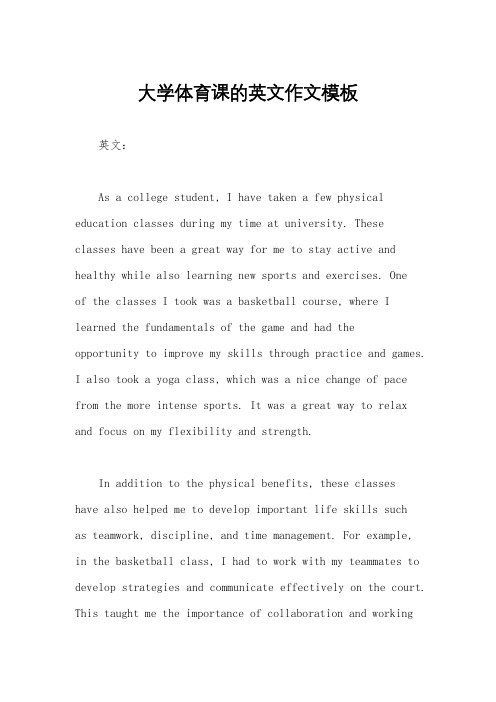
大学体育课的英文作文模板英文:As a college student, I have taken a few physical education classes during my time at university. These classes have been a great way for me to stay active and healthy while also learning new sports and exercises. Oneof the classes I took was a basketball course, where I learned the fundamentals of the game and had theopportunity to improve my skills through practice and games.I also took a yoga class, which was a nice change of pace from the more intense sports. It was a great way to relax and focus on my flexibility and strength.In addition to the physical benefits, these classeshave also helped me to develop important life skills suchas teamwork, discipline, and time management. For example,in the basketball class, I had to work with my teammates to develop strategies and communicate effectively on the court. This taught me the importance of collaboration and workingtowards a common goal. In the yoga class, I learned the importance of discipline and consistency in my practice, as well as the value of mindfulness and relaxation.Overall, I have found my college physical education classes to be both enjoyable and beneficial. They have allowed me to stay active, learn new skills, and develop important life skills that will serve me well in the future.中文:作为一名大学生,我在大学期间参加了一些体育课程。
大学体育课程教学大纲

英文名称大学体育》课程教学大纲:Syllabus of the course of College Physical Education学时数:112 学分数:6开课学期:第一、二、三、四学期课程类别:通识教育平台课程课程性质:必修课一、课程的性质和目的《大学体育》是普通高等学校本科学生的必修课程之一。
通过教学,使学生系统地了解体育运动的理论知识,掌握专项运动的基本技术、战术,具备临场比赛的组织和实战能力,培养学生团结协作,克服困难,吃苦耐劳,勇往直前的品质,最终达到锻炼身体,增强体质,]提高兴趣,终身受益的目的。
二、课程教学内容第一章篮球主要内容和要求1、概述2、基本技术3、基本战术4、竞赛规则和裁判法简介5、三人制篮球赛规则简介教学重点1、传接球、投篮、运球。
2、快攻与防守快攻。
3、人盯人防守与进攻人盯人防守。
4、区域联防与进攻区域连防。
教学难点:技术动作的熟练性、准确性和各技术动作的衔接性及攻防配合。
第二章排球基本内容和要求1、排球运动概述。
2、排球基本技术。
3、排球基本战术。
排球竞赛规则及裁判法。
4、沙滩排球的规则简介。
教学重点:1、阵容配备。
2、进攻阵形。
3、接发球及进攻。
4、接扣球及进攻。
教学难点:传球、扣球、技术之间的串连,战术的变化、战术意识的培养、进攻与防守的平衡。
第三章足球1、概述。
2、基本技术。
3、基本战术。
4、规则简介。
5、室内五人制足球运动。
教学重点:1、踢球、接球、运球过人。
2、个人战术、局部战术、整体战术。
3、定位球战术。
教学难点:各种脚法以及身体各部位的停接球技术,选位、盯人、抢截、整体进攻配合和整体防守配合的战术意识。
第四章乒乓球基本内容和要求:1、概述。
2、基本技术。
3、基本战术。
4、乒乓球常识及竞赛规则、规程。
教学重点:1、基本步法、发球、接发球、搓球、正手攻球。
2、发球抢攻、搓攻、推攻、拉攻。
3、击球时间、击球部位、击球点。
教学难点:正手攻球、发球、搓球、弧圈球、步伐移动等技术动作的熟练性、准确性。
大学体育课程中英文简介
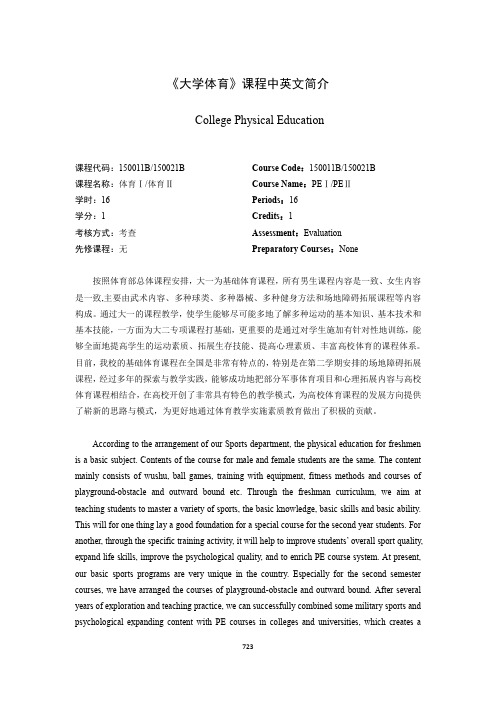
《大学体育》课程中英文简介College Physical Education课程代码:150011B/150021B Course Code:150011B/150021B课程名称:体育Ⅰ/体育ⅡCourse Name:PEⅠ/PEⅡ学时:16 Periods:16学分:1 Credits:1考核方式:考查Assessment:Evaluation先修课程:无Preparatory Courses:None按照体育部总体课程安排,大一为基础体育课程,所有男生课程内容是一致、女生内容是一致,主要由武术内容、多种球类、多种器械、多种健身方法和场地障碍拓展课程等内容构成。
通过大一的课程教学,使学生能够尽可能多地了解多种运动的基本知识、基本技术和基本技能,一方面为大二专项课程打基础,更重要的是通过对学生施加有针对性地训练,能够全面地提高学生的运动素质、拓展生存技能、提高心理素质、丰富高校体育的课程体系。
目前,我校的基础体育课程在全国是非常有特点的,特别是在第二学期安排的场地障碍拓展课程,经过多年的探索与教学实践,能够成功地把部分军事体育项目和心理拓展内容与高校体育课程相结合,在高校开创了非常具有特色的教学模式,为高校体育课程的发展方向提供了崭新的思路与模式,为更好地通过体育教学实施素质教育做出了积极的贡献。
According to the arrangement of our Sports department, the physical education for freshmen is a basic subject. Contents of the course for male and female students are the same. The content mainly consists of wushu, ball games, training with equipment, fitness methods and courses of playground-obstacle and outward bound etc. Through the freshman curriculum, we aim at teaching students to master a variety of sports, the basic knowledge, basic skills and basic ability. This will for one thing lay a good foundation for a special course for the second year students. For another, through the specific training activity, it will help to improve students’ overall sport quality, expand life skills, improve the psychological quality, and to enrich PE course system. At present, our basic sports programs are very unique in the country. Especially for the second semester courses, we have arranged the courses of playground-obstacle and outward bound. After several years of exploration and teaching practice, we can successfully combined some military sports and psychological expanding content with PE courses in colleges and universities, which creates avery unique teaching model. The sports programs provide a new direction of ideas and models for the development of PE in universities, and make a positive contribution to students’ all-around development through physical education.《大学体育》课程中英文简介College Physical Education课程代码:150031B/150041B Course Code:150031B/150041B课程名称:体育Ⅲ/体育ⅣCourse Name:PEⅢ/PEⅣ学时:16 Periods:16学分:1 Credits:1考核方式:考查Assessment:Evaluation先修课程:Preparatory Courses:大学二年级体育课程为必修课程,开设的课程是专项体育课程,在两个学期中学生专修一项体育课程,培养一项较为突出的体育特长。
大学体育课程教学大纲

英文名称大学体育》课程授课大纲:S yllabus of the course of College Physical Education学时数: 112学分数:6开课学期:第一、二、三、四学期课程种类:通识教育平台课程课程性质:必修课一、课程的性质和目的《大学体育》是一般高等学校本科学生的必修课程之一。
经过授课,使学生系统地认识体育运动的理论知识,掌握专项运动的基本技术、战术,具备临场竞赛的组织和实战能力,培养学生团结协作,战胜困难,吃苦耐劳,一往直前的质量,最后达到锻炼身体,加强体质,] 提快乐趣,平生受益的目的。
二、课程授课内容第一章篮球主要内容和要求1、归纳2、基本技术3、基本战术4、竞赛规则和裁判法简介5、三人制篮球赛规则简介授课重点1、传接球、投篮、运球。
2、快攻与防守快攻。
3、人盯人防守与攻击人盯人防守。
4、地域联防与攻击地域连防。
授课难点:技术动作的熟练性、正确性和各技术动作的连结性及攻防配合。
第二章排球基本内容和要求1、排球运动归纳。
2、排球基本技术。
3、排球基本战术。
排球竞赛规则及裁判法。
4、沙滩排球的规则简介。
授课重点:1、阵容装备。
2、攻击阵形。
3、接发球及攻击。
4、接扣球及攻击。
授课难点:传球、扣球、技术之间的串联,战术的变化、战术意识的培养、攻击与防守的平衡。
第三章足球1、归纳。
2、基本技术。
3、基本战术。
4、规则简介。
5、室内五人制足球运动。
授课重点:1、踢球、接球、运球过人。
2、个人战术、局部战术、整体战术。
3、定位球战术。
授课难点:各种脚法以及身体各部位的停接球技术,选位、盯人、抢截、整体攻击配合和整体防守配合的战术意识。
第四章乒乓球基本内容和要求:1、归纳。
2、基本技术。
3、基本战术。
4、乒乓球知识及竞赛规则、规程。
授课重点:1、基本步法、发球、接发球、搓球、正手攻球。
2、发球抢攻、搓攻、推攻、拉攻。
3、击球时间、击球部位、击球点。
授课难点:正手攻球、发球、搓球、弧圈球、步伐搬动等技术动作的熟练性、正确性。
大学中常见课程和系别中英文对照

Practical English:大学常见课程中英文对照大学英语English高等数学Advanced Mathematics体育Physical Education军事理论Military Theory机械制图Mechanical Graphing算法语言Algorithmic Language大学物理College Physics物理实验Experiment of College Physics线性代数Linear Algebra法律基础Fundamentals of Law普通物理General Physics普通物理实验Lab of General Physics复变函数与积分变换Functions of Complex Variables & Integral Transformations电路理论Theory of Circuitry电路测试技术Circuit Measurement Technology概率论与随机过程Probability Theory & Stochastic Process信号与线性系统Signal & Linear System电子线路Circuitry脉冲与数字电路Pulse & Numerical Circuitry金工实习Metalworking Practice电工实习Electrical Engineering Practice电子线路实验Experiment in Electronic Circuitry微机原理Principle of Microcomputer电磁场与电磁波Electromagnetic Fields & Magnetic Waves 电机电器与供电Motor Elements and Power Supply计算方法Computational Method软件技术基础Basis of Software Technique微波技术Microwave Technique通讯原理Principle of Communication数字信号处理Digital Signal Processing微机实验Experiment of Microcomputer计算机接口技术Computer Interface Technologyc 语言 C languageCET-6College English Test (Band 6)工业企业管理Industrial Enterprise Management移动通讯Moving Communication光纤通讯系统Fiber Optical Communication System可靠性技术导论Introduction to Reliability Technology卫星通信Satellite Communications电视原理Television Operation数字图象处理Digital Image Processing专业英语Specialty English情报检索Information Searches毕业设计Graduation Thesis自动控制理论Automatic Control Theory模拟电子电路Analogical Electronics数字电子电路Digital Electronics资本主义经济Economy of Capitalism马克思主义原理Principle of Marxism机械原理Principle of Mechanic机械设计Mechanic Design最优控制Optimum Control微机控制技术Microcomputer Control Technology 过程控制Procedure Control自动控制系统Automatic Control System半导体变流技术Semiconductor converting Technique 运筹学Operational Research自动检测技术Auto-Measurement Technique传感器原理Principle of Sensing Device单片机原理Principle of Single-Chip computerHxenEnglishPractical English:大学系别名称中英文对照会计系 Dept. of Accounting农业系Dept.of Agriculture农业经济系 Dept.of Agricultural Economics农业化学系Dept.of Agricultural Chemistry农业工程系 Dept.of Agricultural Engineering畜牧系Dept.of Animal Husbandry人类学系 Dept.of Anthropology应用数学系Dept.of Applied Mathematics建筑系Dept. of Architecture考古学系Dept.of Archaeology天文系Dept.of Astronomy原子能系Dept.of Atomic Energy解剖系Dept. of Anatomy金融系 Dept.of Banking工商管理系Dept.of Business Administration生物学系Dept.of Biology生物化学系Dept.of Biochemistry植物学系Dept.of Botany细菌学系 Dept.of Bacteriology中文系Dept.of Chinese化学系Dept.of Chemistry化学工程系Dept.of Chemical Engineering控制工程系 Dept. of Control Engineering电信工程系Dept. of Communication Engineering 计算机科学系Dept.of Computer Science电脑资讯系 Dept.of Computer Information土木工程系 Dept.of Civil Engineering舞蹈系 Dept. of Dance牙科学系Dept.of Dentistry营养学系Dept.of Dietetics外交学系Dept.of Diplomacy经济系Dept.of Economics教育系Dept.of Education工程系 Dept.of Engineering环境工程系 Dept.of Environmental Engineering 英语系Dept. of English昆虫系 Dept.of Entomology电子物理系Dept.of Electrophysics电子工程系 Dept.of Electronic Engineering电机工程系 Dept.of Electrical Engineering眼耳鼻喉系Dept. of Eye, Ear, Nose and Throat渔业学系Dept.of Fishery水产学系 Dept.of Fishery Technology食品科学系 Dept.of Food Science外语系Dept. of Foreign Languages森林系Dept.of Forestry遗传系 Dept.of Genetics地理系 Dept.of Geography地质系Dept. of Geology地球物理系Dept.of Geophysics历史系 Dept.of History园艺系Dept.of Horticulture国际关系学系Dept.of International Relations 国际贸易系Dept. of International Trade工业设计系Dept. of Industrial Design工业管理系 Dept.of Industrial Management 新闻学系 Dept. of Journalism法律系Dept.of Law图书管理系 Dept.of Library Management文学系Dept.of Literature机械工程系Dept.of Mechanical Engineering 冶金系Dept.of Metallurgy管理科学系Dept.of Management Science大众传播系 Dept.of Mass Communication医学系 Dept.of Medical Science海洋运输学系 Dept.of Marine Transportation 航海技术系 Dept.of Maritime Technology 数学系Dept.of Mathematics气象系 Dept.of Meteorology矿业系 Dept.of Mining核子工程系Dept.of Nuclear Enginerring护理系Dept.of Nursing航海学系Dept.of Navigation海洋科学系 Dept.of Nautical Science造船学系Dept.of Naval Architecture 东方语言系Dept.of Oriental languages 海洋学系Dept.of Oceanography海洋气象学系 Dept. of Ocean Meteorology 石油系Dept.of Oil药学系Dept.of Pharmacology病理学系Dept.of Pathology政治系 Dept.of Political Science物理系Dept.of Physics体育系 Dept.of Physical Culture生理学系Dept.of Physiology植物病虫学系Dept.of Plant Pathology 植物生理系Dept.of Plant Physiology 哲学系Dept. of Philosophy电力物理系 Dept.of Power Physics印刷系Dept.of Printing公共卫生学系 Dept.of Public Health卫生工程学系Dept.of Sanitary Engineering土壤系Dept. of Soil纺织系Dept.of Spinning社会学系Dept.of Sociology测量系Dept.of Survey纺织工程系 Dept.of Textile Engineering戏剧系Dept.of Theatricals运输管理系Dept.of Transportation Management兽医学系 Dept. of Veterinary Medicine水利系Dept. of Water Conservancy水土保持系Dept. of Water & Soil Maintenance Engineering 西方语言系 Dept. of Western Languages动物学系Dept.of ZoologyHjiangEnglish。
大学体育英语教案

课程名称:大学英语体育模块课时:2课时教学对象:大学一年级学生教学目标:1. 培养学生对体育英语的兴趣,提高他们的英语听说能力。
2. 帮助学生掌握基本的体育英语词汇和短语,能够进行简单的体育交流。
3. 通过体育活动,增进学生之间的团队合作和沟通能力。
教学内容:1. 体育英语基础词汇和短语2. 体育活动介绍3. 体育英语口语练习教学步骤:第一课时:一、导入1. 教师简要介绍本节课的主题和目标。
2. 学生自由讨论他们对体育活动的看法和兴趣。
二、新授1. 教师带领学生复习并学习以下体育英语基础词汇和短语:- 运动项目:basketball, football, volleyball, tennis, swimming, running, etc.- 体育器材:ball, racket, net, track, pool, etc.- 身体部位:head, shoulder, arm, leg, foot, etc.- 动作描述:hit, kick, serve, jump, run, etc.2. 教师展示图片或视频,让学生用所学的词汇和短语描述体育活动。
三、练习1. 学生分组,进行体育英语口语练习,如:- 描述一个运动项目;- 介绍自己的运动爱好;- 讨论运动对身体的好处。
2. 教师巡回指导,纠正学生的发音和语法错误。
四、总结1. 教师对本节课所学内容进行总结,强调重点词汇和短语。
2. 学生分享自己的学习心得和收获。
第二课时:一、复习1. 教师带领学生复习上节课所学的基础词汇和短语。
2. 学生进行小组竞赛,看谁能够用所学的词汇和短语描述体育活动。
二、新授1. 教师介绍几种常见的体育活动,如:- 篮球:basketball- 足球:football- 网球:tennis- 羽毛球:badminton- 游泳:swimming2. 教师讲解这些体育活动的起源、规则和特点。
三、练习1. 学生分组,进行角色扮演,模拟一场篮球比赛或足球比赛。
《大学体育》课教学大纲 - 副本
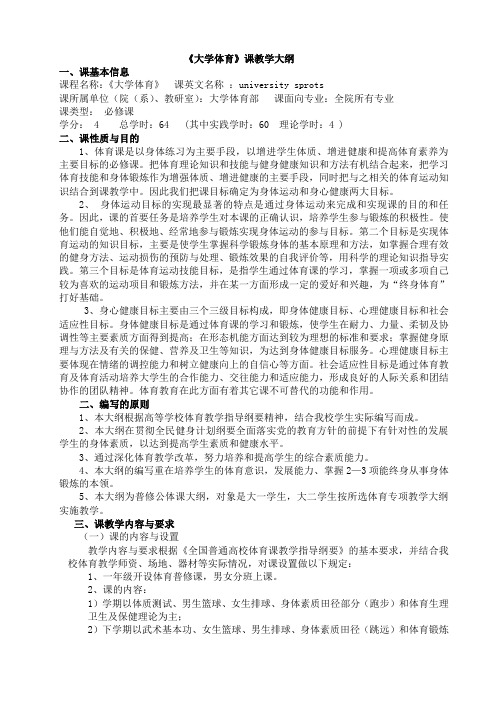
《大学体育》课教学大纲一、课基本信息课程名称:《大学体育》课英文名称:university sprots课所属单位(院(系)、教研室):大学体育部课面向专业:全院所有专业课类型:必修课学分: 4 总学时:64 (其中实践学时:60 理论学时:4 )二、课性质与目的1、体育课是以身体练习为主要手段,以增进学生体质、增进健康和提高体育素养为主要目标的必修课。
把体育理论知识和技能与健身健康知识和方法有机结合起来,把学习体育技能和身体锻炼作为增强体质、增进健康的主要手段,同时把与之相关的体育运动知识结合到课教学中。
因此我们把课目标确定为身体运动和身心健康两大目标。
2、身体运动目标的实现最显著的特点是通过身体运动来完成和实现课的目的和任务。
因此,课的首要任务是培养学生对本课的正确认识,培养学生参与锻炼的积极性。
使他们能自觉地、积极地、经常地参与锻炼实现身体运动的参与目标。
第二个目标是实现体育运动的知识目标,主要是使学生掌握科学锻炼身体的基本原理和方法,如掌握合理有效的健身方法、运动损伤的预防与处理、锻炼效果的自我评价等,用科学的理论知识指导实践。
第三个目标是体育运动技能目标,是指学生通过体育课的学习,掌握一项或多项自己较为喜欢的运动项目和锻炼方法,并在某一方面形成一定的爱好和兴趣,为“终身体育”打好基础。
3、身心健康目标主要由三个三级目标构成,即身体健康目标、心理健康目标和社会适应性目标。
身体健康目标是通过体育课的学习和锻炼,使学生在耐力、力量、柔韧及协调性等主要素质方面得到提高;在形态机能方面达到较为理想的标准和要求;掌握健身原理与方法及有关的保健、营养及卫生等知识,为达到身体健康目标服务。
心理健康目标主要体现在情绪的调控能力和树立健康向上的自信心等方面。
社会适应性目标是通过体育教育及体育活动培养大学生的合作能力、交往能力和适应能力,形成良好的人际关系和团结协作的团队精神。
体育教育在此方面有着其它课不可替代的功能和作用。
课程名称中英文对照

计算机文化基础95 2.5computer science introduction道路工程制图与CAD952highway engineering drawing and CAD工程化学95 2.5engineering chemistry大学英语814colledge english思想道德修养952Moral Education马克思主义哲学原理78 2.5Marxist philosophy principles大学体育89 1.5college physical education高等数学A93 4.5advanced math90.125VB程序设计95 3.5VB program design道路工程制图与CAD952highway engineering drawing and CAD理论力学92 3.5Theoretical Mechanics大学物理86 3.5colledge Physics大学物理实验85 1.25colledge Physics experiments大学英语76 4.5college english高等数学946advanced english法律基础952basic law大学体育952College Sports education线性代数95 2.5 linear algebras90.8筑材集中训练953intensive training of Building material材料力学854material mechanics大学物理实验85 1.25colledge Physics experiments大学物理89 3.5colledge Physics大学英语85 4.5colledge english马克思主义政治经济学852Marxist political economy大学体育802College Sports education概率论与数理统计953Probability and Mathematical Statistics道路建筑材料693material for highway construction85.33333认识实习951practice of structure understanding测量学90 3.5Surveying technology工程地质952Engineering Geology地质实习751Geology Practice土质学与土力学663Soil science and soil mechanics结构力学90 4.5structure mechanics大学英语77 4.5colledge english毛泽东思想概论852An Introduction to Mao Zedong Thoughts大学体育852College Sports education84.22222专业英语95 1.5major english水力学与水文学753Hydraulics and Hydrology测量实习754surveying practice土工集中训练851intensive training of solid mechanics experim 结构设计原理82 4.5Design of Reinforced Concrete Structures预应力砼简支梁设计951practice design of pre-stressed concrete simp 邓小平理论和三个代表重要思想703Deng Xiaoping Theory and 'Sangedaibiao' important th 路基路面工程71 2.5Pavement Engineering桥梁美学95 1.5bridge aesthetics工程地质分析原理95 1.5Principles of engineering geological analysis 跨文化交际85 1.5cross-culture communication83.90909专业英语95 1.5major english路基路面综合设计851foundation and pavement general design预应力砼简支梁桥设计751practice design of pre-stressed concrete simp 公路施工概算与项目管理71 2.5highway construction buget and management施工实习753construction practiceVF数据库85 2.5VF database道路勘测设计基础68 4.5basics for highway survying and design路基路面工程71 2.5Pavement Engineering桥梁工程685bridge engineering城市道路85 1.5urban highway中小桥涵测设85 1.5surveying and design of medium or bridge外教英语口语95 1.5native speaker training of spoken english79.83333道路勘测实习753practice of highway survying路线平纵横综合设计852highway line design专业外语85 1.5major english基础工程722Foundation Engineering公路桥梁工程施工852highway bridge construction公路工程造价与评价602highway engineering budget and evaluation形势与政策753Situation and Policy文献检索951references index公路路线CAD技术95 1.5CAD in highway line design桥梁电算75 1.5computer based calculation for bridge80.2土木工程毕业设计8514graduation design毕业设计论文答辩851interview of graduation design公路施工组织与概预算852highway construction management and budget85平均84.62516044.5总数-道路86.27692191.5加权平均83.78329terialical Statisticsong Thoughtsd mechanics experiments ete Structuresessed concrete simply supported beam gedaibiao' important thoughtgeological analysisneral designessed concrete simply supported beam bridge and managementg and designdium or bridgespoken englishand evaluationfor bridgeement and budget。
大学中常见课程和系别中英文对照

Practical English:大学常见课程中英文对照大学英语English高等数学Advanced Mathematics体育Physical Education军事理论Military Theory机械制图Mechanical Graphing算法语言Algorithmic Language大学物理College Physics物理实验Experiment of College Physics线性代数Linear Algebra法律基础Fundamentals of Law普通物理General Physics普通物理实验Lab of General Physics复变函数与积分变换Functions of Complex Variables & Integral Transformations电路理论Theory of Circuitry电路测试技术Circuit Measurement Technology概率论与随机过程Probability Theory & Stochastic Process信号与线性系统Signal & Linear System电子线路Circuitry脉冲与数字电路Pulse & Numerical Circuitry金工实习Metalworking Practice电工实习Electrical Engineering Practice电子线路实验Experiment in Electronic Circuitry微机原理Principle of Microcomputer电磁场与电磁波Electromagnetic Fields & Magnetic Waves 电机电器与供电Motor Elements and Power Supply计算方法Computational Method软件技术基础Basis of Software Technique微波技术Microwave Technique通讯原理Principle of Communication数字信号处理Digital Signal Processing微机实验Experiment of Microcomputer计算机接口技术Computer Interface Technologyc 语言 C languageCET-6College English Test (Band 6)工业企业管理Industrial Enterprise Management移动通讯Moving Communication光纤通讯系统Fiber Optical Communication System可靠性技术导论Introduction to Reliability Technology卫星通信Satellite Communications电视原理Television Operation数字图象处理Digital Image Processing专业英语Specialty English情报检索Information Searches毕业设计Graduation Thesis自动控制理论Automatic Control Theory模拟电子电路Analogical Electronics数字电子电路Digital Electronics资本主义经济Economy of Capitalism马克思主义原理Principle of Marxism机械原理Principle of Mechanic机械设计Mechanic Design最优控制Optimum Control微机控制技术Microcomputer Control Technology 过程控制Procedure Control自动控制系统Automatic Control System半导体变流技术Semiconductor converting Technique 运筹学Operational Research自动检测技术Auto-Measurement Technique传感器原理Principle of Sensing Device单片机原理Principle of Single-Chip computerHxenEnglishPractical English:大学系别名称中英文对照会计系 Dept. of Accounting农业系Dept.of Agriculture农业经济系 Dept.of Agricultural Economics农业化学系Dept.of Agricultural Chemistry农业工程系 Dept.of Agricultural Engineering畜牧系Dept.of Animal Husbandry人类学系 Dept.of Anthropology应用数学系Dept.of Applied Mathematics建筑系Dept. of Architecture考古学系Dept.of Archaeology天文系Dept.of Astronomy原子能系Dept.of Atomic Energy解剖系Dept. of Anatomy金融系 Dept.of Banking工商管理系Dept.of Business Administration生物学系Dept.of Biology生物化学系Dept.of Biochemistry植物学系Dept.of Botany细菌学系 Dept.of Bacteriology中文系Dept.of Chinese化学系Dept.of Chemistry化学工程系Dept.of Chemical Engineering控制工程系 Dept. of Control Engineering电信工程系Dept. of Communication Engineering 计算机科学系Dept.of Computer Science电脑资讯系 Dept.of Computer Information土木工程系 Dept.of Civil Engineering舞蹈系 Dept. of Dance牙科学系Dept.of Dentistry营养学系Dept.of Dietetics外交学系Dept.of Diplomacy经济系Dept.of Economics教育系Dept.of Education工程系 Dept.of Engineering环境工程系 Dept.of Environmental Engineering 英语系Dept. of English昆虫系 Dept.of Entomology电子物理系Dept.of Electrophysics电子工程系 Dept.of Electronic Engineering电机工程系 Dept.of Electrical Engineering眼耳鼻喉系Dept. of Eye, Ear, Nose and Throat渔业学系Dept.of Fishery水产学系 Dept.of Fishery Technology食品科学系 Dept.of Food Science外语系Dept. of Foreign Languages森林系Dept.of Forestry遗传系 Dept.of Genetics地理系 Dept.of Geography地质系Dept. of Geology地球物理系Dept.of Geophysics历史系 Dept.of History园艺系Dept.of Horticulture国际关系学系Dept.of International Relations 国际贸易系Dept. of International Trade工业设计系Dept. of Industrial Design工业管理系 Dept.of Industrial Management 新闻学系 Dept. of Journalism法律系Dept.of Law图书管理系 Dept.of Library Management文学系Dept.of Literature机械工程系Dept.of Mechanical Engineering 冶金系Dept.of Metallurgy管理科学系Dept.of Management Science大众传播系 Dept.of Mass Communication医学系 Dept.of Medical Science海洋运输学系 Dept.of Marine Transportation 航海技术系 Dept.of Maritime Technology 数学系Dept.of Mathematics气象系 Dept.of Meteorology矿业系 Dept.of Mining核子工程系Dept.of Nuclear Enginerring护理系Dept.of Nursing航海学系Dept.of Navigation海洋科学系 Dept.of Nautical Science造船学系Dept.of Naval Architecture 东方语言系Dept.of Oriental languages 海洋学系Dept.of Oceanography海洋气象学系 Dept. of Ocean Meteorology 石油系Dept.of Oil药学系Dept.of Pharmacology病理学系Dept.of Pathology政治系 Dept.of Political Science物理系Dept.of Physics体育系 Dept.of Physical Culture生理学系Dept.of Physiology植物病虫学系Dept.of Plant Pathology 植物生理系Dept.of Plant Physiology 哲学系Dept. of Philosophy电力物理系 Dept.of Power Physics印刷系Dept.of Printing公共卫生学系 Dept.of Public Health卫生工程学系Dept.of Sanitary Engineering土壤系Dept. of Soil纺织系Dept.of Spinning社会学系Dept.of Sociology测量系Dept.of Survey纺织工程系 Dept.of Textile Engineering戏剧系Dept.of Theatricals运输管理系Dept.of Transportation Management兽医学系 Dept. of Veterinary Medicine水利系Dept. of Water Conservancy水土保持系Dept. of Water & Soil Maintenance Engineering 西方语言系 Dept. of Western Languages动物学系Dept.of ZoologyHjiangEnglish。
体育在大学的重要性英语作文

体育在大学的重要性英语作文【中英文实用版】The importance of sports in university cannot be overstated.Engaging in physical activities not only helps students maintain a healthy lifestyle but also fosters essential life skills such as teamwork, discipline, and perseverance.体育在大学中的重要性不言而喻。
参与体育活动不仅有助于学生保持健康的生活方式,还能培养如团队合作、自律和毅力等重要生活技能。
University sports provide a platform for students to relieve stress and anxiety, which are common issues faced during academic pursuits.Moreover, participating in sports can enhance cognitive function and improve academic performance.大学体育为学生提供了一个缓解学习和生活中压力与焦虑的平台,这些问题在学习过程中尤为常见。
此外,参与体育活动还能提升认知功能并提高学术成绩。
Sports competitions on campus encourage a sense of community and school spirit, as students come together to support their peers.This sense of unity and camaraderie is invaluable in creating a positive university experience.校园体育竞赛激发了学生的社区意识和学校精神,因为学生们会团结起来支持彼此。
大学生体育课计划

大学生体育课计划(中英文版)**University Students" PE Class Schedule**As an essential part of higher education, physical education (PE) classes play a significant role in the overall development of university students.To ensure a well-rounded education, most universities require students to participate in PE courses.These classes not only promote physical fitness but also contribute to the development of social skills, teamwork, and sportsmanship.体育课是高等教育的重要组成部分,它在大学生的全面发展中起着重要作用。
为了确保全面的教育,大多数大学要求学生参加体育课程(PE)。
这些课程不仅促进身体健康,还有助于培养社交技能、团队合作和体育精神。
The PE curriculum typically includes a variety of sports and activities to cater to different interests and abilities.Some common sports included in the curriculum are basketball, soccer, volleyball, badminton, and swimming.Additionally, there are often fitness classes such as yoga, Pilates, and aerobics.These activities help students to stay active, improve their skills, and learn new techniques.体育课程通常包括各种运动和活动,以满足不同兴趣和能力的需求。
大学体育教育英语教材
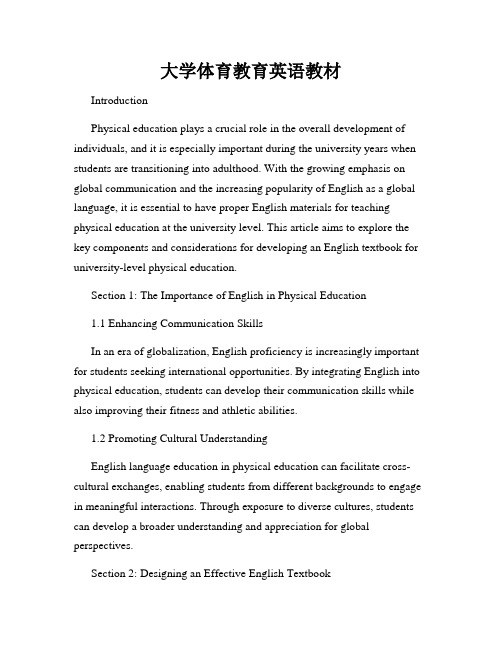
大学体育教育英语教材IntroductionPhysical education plays a crucial role in the overall development of individuals, and it is especially important during the university years when students are transitioning into adulthood. With the growing emphasis on global communication and the increasing popularity of English as a global language, it is essential to have proper English materials for teaching physical education at the university level. This article aims to explore the key components and considerations for developing an English textbook for university-level physical education.Section 1: The Importance of English in Physical Education1.1 Enhancing Communication SkillsIn an era of globalization, English proficiency is increasingly important for students seeking international opportunities. By integrating English into physical education, students can develop their communication skills while also improving their fitness and athletic abilities.1.2 Promoting Cultural UnderstandingEnglish language education in physical education can facilitate cross-cultural exchanges, enabling students from different backgrounds to engage in meaningful interactions. Through exposure to diverse cultures, students can develop a broader understanding and appreciation for global perspectives.Section 2: Designing an Effective English Textbook2.1 Curriculum IntegrationThe English textbook for university-level physical education should be integrated seamlessly into the existing curriculum. The content should align with the specific goals and learning outcomes of the physical education program, ensuring that English language learning complements students' overall development.2.2 Engaging Content and ActivitiesTo maintain students' interest and motivation, the textbook should include engaging content and interactive activities. These activities can incorporate real-life scenarios, such as discussing sports-related topics or analyzing sports news articles, to encourage active participation and critical thinking.2.3 Progressive Difficulty LevelsThe textbook should be designed with progressive difficulty levels to cater to students with varying levels of English proficiency. Starting with basic vocabulary and grammar, subsequent units should gradually increase in complexity to challenge students and foster their language development.Section 3: Topics and Units in the English Textbook3.1 Introduction to Sports and FitnessThis section will cover fundamental topics related to sports and fitness, introducing key vocabulary, basic rules, and common sports terminology. It will also incorporate practical exercises to enhance students' understanding and application of the English language in a sports context.3.2 Health and NutritionHighlighting the importance of a healthy lifestyle, this unit will focus on health-related topics, such as exercise benefits, balanced diets, and injury prevention. Students will engage in discussions, role plays, and presentations related to health and nutrition, reinforcing their English proficiency while promoting well-being.3.3 Sports PsychologyThis unit will explore the psychological aspects of sports, including topics such as motivation, goal-setting, and teamwork. Through group activities and reflective writing exercises, students will enhance their language skills while gaining valuable insights into the mental aspects of athletics.3.4 Sports and SocietyExamining the social impact of sports, this unit will encourage students to analyze sports events, controversies, and the role of athletes as influencers. Discussions on sports ethics, gender equality, and inclusivity will promote critical thinking and foster students' ability to express their opinions in English.ConclusionDeveloping an English textbook for university-level physical education requires careful consideration of curriculum integration, engaging content, and progressive difficulty levels. By incorporating English language learning with sports and fitness, students can enhance their communication skills,promote cultural understanding, and develop a well-rounded approach to their physical education.。
大学体育课教案英语文案
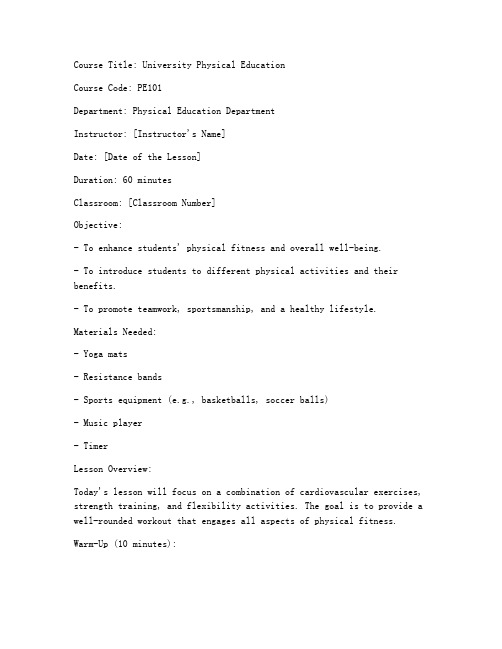
Course Title: University Physical EducationCourse Code: PE101Department: Physical Education DepartmentInstructor: [Instructor's Name]Date: [Date of the Lesson]Duration: 60 minutesClassroom: [Classroom Number]Objective:- To enhance students' physical fitness and overall well-being.- To introduce students to different physical activities and their benefits.- To promote teamwork, sportsmanship, and a healthy lifestyle.Materials Needed:- Yoga mats- Resistance bands- Sports equipment (e.g., basketballs, soccer balls)- Music player- TimerLesson Overview:Today's lesson will focus on a combination of cardiovascular exercises, strength training, and flexibility activities. The goal is to provide a well-rounded workout that engages all aspects of physical fitness.Warm-Up (10 minutes):1. Dynamic Stretching: Students will perform a series of dynamic stretches to increase blood flow and prepare the muscles for activity. Activities include leg swings, arm circles, and torso twists.2. Jumping Jacks: To raise the heart rate and warm up the muscles, students will perform a set of jumping jacks for 1 minute.3. High Knees: A brisk running in place with high knees to further warm up the lower body for the upcoming exercises.Cardiovascular Exercise (15 minutes):1. Running in Place: Students will start with a 5-minute run in place, increasing their intensity by jogging on the spot.2. Jump Rope: Students will practice jumping rope for 3 minutes, focusing on coordination and rhythm.3. Burpees: A series of burpees will be performed for 2 minutes, aiming to increase the heart rate and build endurance.Strength Training (15 minutes):1. Yoga Flow: Students will engage in a series of yoga poses that target different muscle groups. The flow will include Sun Salutations, Downward Dog, Warrior poses, and Child's Pose.2. Resistance Band Exercises: Using resistance bands, students will perform exercises such as bicep curls, tricep extensions, and lateral raises to strengthen their arms and shoulders.3. Bodyweight Squats: Students will perform bodyweight squats, focusing on proper form and depth to target the legs and glutes.Flexibility and Cool Down (10 minutes):1. Static Stretching: Students will perform a series of static stretches to improve flexibility. This will include stretches for the hamstrings, quads, calves, and back.2. Deep Breathing: Students will engage in deep breathing exercises to relax their bodies and minds.3. Cool Down Music: Soft music will be played as students perform a slow walk and gentle stretches to gradually lower their heart rate.Instructor's Notes:- Encourage students to listen to their bodies and modify exercises as needed.- Demonstrate proper form for each exercise and provide individual guidance.- Keep the class atmosphere positive and supportive, emphasizing teamwork and sportsmanship.- Monitor students' progress and provide feedback to encourage continuous improvement.Assessment:- Observation of students' participation and engagement throughout the class.- Assessment of students' ability to perform exercises with proper form.- Feedback from students regarding their enjoyment and perceivedbenefits of the class.Homework:- Students are encouraged to continue their fitness journey by incorporating daily physical activity into their routine.- Optional: Students can research a new physical activity and prepare a short presentation to share with the class in the next session.Emergency Procedures:- All students must complete a physical fitness assessment before participating in class.- In case of an injury, students should immediately inform theinstructor and seek medical attention if necessary.- Emergency exits and first aid kits are readily accessible in the classroom.End of Lesson Plan。
大学体育课教案英语
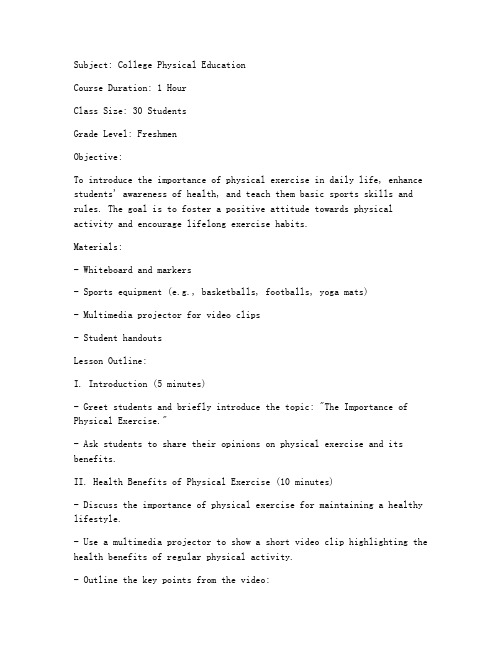
Subject: College Physical EducationCourse Duration: 1 HourClass Size: 30 StudentsGrade Level: FreshmenObjective:To introduce the importance of physical exercise in daily life, enhance students' awareness of health, and teach them basic sports skills and rules. The goal is to foster a positive attitude towards physicalactivity and encourage lifelong exercise habits.Materials:- Whiteboard and markers- Sports equipment (e.g., basketballs, footballs, yoga mats)- Multimedia projector for video clips- Student handoutsLesson Outline:I. Introduction (5 minutes)- Greet students and briefly introduce the topic: "The Importance of Physical Exercise."- Ask students to share their opinions on physical exercise and its benefits.II. Health Benefits of Physical Exercise (10 minutes)- Discuss the importance of physical exercise for maintaining a healthy lifestyle.- Use a multimedia projector to show a short video clip highlighting the health benefits of regular physical activity.- Outline the key points from the video:- Improved cardiovascular health- Weight management- Enhanced mental health and well-being- Increased energy levelsIII. Basic Sports Skills and Rules (20 minutes)- Introduce different sports and their basic rules (e.g., basketball, football, volleyball).- Demonstrate basic skills for each sport, such as dribbling, kicking, and passing.- Organize a small activity session where students can practice these skills under the guidance of the instructor.- Divide the class into groups and assign each group a different sport to focus on.IV. Group Activity: Sports Scavenger Hunt (15 minutes)- Explain the rules of the scavenger hunt, which will involve students searching for items related to different sports.- The items will include: a basketball, a football, a soccer ball, a yoga mat, and a skipping rope.- Students will work in pairs to find the items and return them to the instructor.- The first pair to complete the scavenger hunt correctly will win a small prize.V. Discussion and Reflection (10 minutes)- Gather students for a group discussion on what they learned today.- Ask students to share their experiences during the activity and how they feel about physical exercise.- Encourage students to reflect on the importance of incorporating physical activity into their daily routine.VI. Conclusion (5 minutes)- Summarize the key points of the lesson.- Remind students of the health benefits of regular physical exercise.- Encourage students to continue practicing the sports skills learned during the class and to participate in physical activities outside of school.Assessment:- Participation in class activities and discussions.- Completion of the sports scavenger hunt.- Students' reflections on the importance of physical exercise.Homework:- Students are encouraged to spend 30 minutes per day on physical exercise, either by participating in a sport or by engaging in another form of physical activity.By the end of this lesson, students should have a better understanding of the importance of physical exercise, basic sports skills, and the rules of different sports. They should also be motivated to incorporate regular physical activity into their daily lives.。
大学体育教案模板英语初中
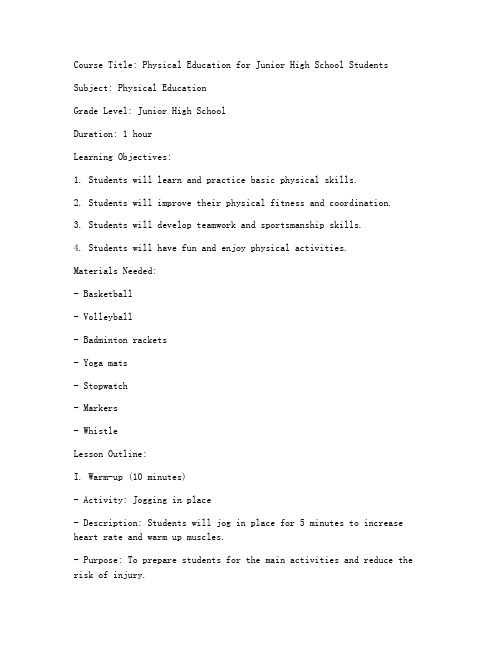
Course Title: Physical Education for Junior High School StudentsSubject: Physical EducationGrade Level: Junior High SchoolDuration: 1 hourLearning Objectives:1. Students will learn and practice basic physical skills.2. Students will improve their physical fitness and coordination.3. Students will develop teamwork and sportsmanship skills.4. Students will have fun and enjoy physical activities.Materials Needed:- Basketball- Volleyball- Badminton rackets- Yoga mats- Stopwatch- Markers- WhistleLesson Outline:I. Warm-up (10 minutes)- Activity: Jogging in place- Description: Students will jog in place for 5 minutes to increase heart rate and warm up muscles.- Purpose: To prepare students for the main activities and reduce the risk of injury.II. Skill Development (20 minutes)- Activity: Basketball shooting- Description: Students will practice shooting a basketball from various distances and angles.- Purpose: To improve hand-eye coordination and shooting accuracy.- Activity: Volleyball serving- Description: Students will practice serving the volleyball overhand and underhand.- Purpose: To develop hand-eye coordination and serve accuracy.- Activity: Badminton forehand and backhand strokes- Description: Students will practice forehand and backhand strokes with a shuttlecock.- Purpose: To improve hand-eye coordination and stroke technique.III. Physical Fitness Activity (15 minutes)- Activity: Relay race- Description: Students will participate in a relay race, alternating between different physical activities such as running, jumping, and catching a ball.- Purpose: To enhance cardiovascular fitness and teamwork.IV. Cool-down and Stretching (5 minutes)- Activity: Stretching exercises- Description: Students will perform a series of stretching exercises to cool down and relax their muscles.- Purpose: To reduce muscle soreness and improve flexibility.V. Conclusion (5 minutes)- Activity: Reflection and feedback- Description: Students will reflect on the lesson and provide feedback on what they enjoyed and what they found challenging.- Purpose: To promote self-assessment and encourage students to set personal goals for future physical activities.Assessment:- Observation: Teacher will observe students' participation, skill development, and teamwork throughout the lesson.- Self-assessment: Students will complete a short self-assessment at the end of the lesson to reflect on their performance.- Peer assessment: Students will provide feedback to their peers based on their teamwork and sportsmanship.Note:- The activities can be adjusted according to the students' abilities and interests.- The lesson plan can be repeated with different activities to provide variety and challenge.---This template provides a structured approach to planning a university-level physical education lesson for junior high school students. It ensures that students receive a well-rounded physical education experience that promotes fitness, skill development, and teamwork.。
大学体育课教案

大学体育课教案Title: Introduction to University Physical Education ClassObjective: The objective of this lesson is to introduce students to the basic concepts and skills of physical education in a university setting.Duration: 1 hourMaterials: Whiteboard, markers, projector, laptop, handoutsIntroduction (10 minutes):1. Greet students and introduce yourself as their physical education instructor.2. Explain the purpose of the course and its importance in maintaining a healthy lifestyle.3. Briefly discuss the benefits of physical activity, such as improved physical and mental health, stress reduction, and better academic performance.4. Encourage students to actively participate in class activities and ask questions throughout the course.Warm-up Activity (10 minutes):1. Lead students through a dynamic warm-up routine, consisting of stretching exercises, jogging in place, and jumping jacks.2. Emphasize the importance of warming up before physical activity to prevent injuries.Main Content (30 minutes):1. Introduce different components of physical fitness, such ascardiovascular endurance, muscular strength, flexibility, and body composition.2. Explain each component in detail, discussing its importance and how it contributes to overall fitness.3. Show visual aids or video clips to demonstrate various fitness activities that target each component (e.g., running to improve cardiovascular endurance, weightlifting to build muscular strength).4. Discuss the guidelines for safe and effective physical exercise, such as proper form, appropriate intensity, and gradual progression.5. Use real-life examples to help students understand how physical fitness can be integrated into their daily lives.Activity Demonstration (20 minutes):1. Split students into small groups and assign each group a specific fitness activity.2. Each group will prepare a short demonstration of the assigned activity, including warm-up exercises, the actual activity, and cool-down stretches.3. Groups will present their demonstrations to the whole class, allowing students to observe and learn from each other.4. Provide feedback and offer suggestions for improvement after each presentation.Conclusion (10 minutes):1. Summarize the key points discussed during the lesson, emphasizing the importance of physical fitness in university life.2. Encourage students to actively participate in future classes and take advantage of the facilities and resources available on campus.3. Briefly mention the upcoming lessons and activities that will be covered in the course.Assessment:1. Observe students' participation and engagement throughout the lesson.2. Evaluate the quality of group demonstrations and provide constructive feedback.3. Encourage students to ask questions and clarify any doubts they may have.。
- 1、下载文档前请自行甄别文档内容的完整性,平台不提供额外的编辑、内容补充、找答案等附加服务。
- 2、"仅部分预览"的文档,不可在线预览部分如存在完整性等问题,可反馈申请退款(可完整预览的文档不适用该条件!)。
- 3、如文档侵犯您的权益,请联系客服反馈,我们会尽快为您处理(人工客服工作时间:9:00-18:30)。
体育部
《大学体育》课程中英文简介
College Physical Education
课程代码:150011B/150021B Course Code:150011B/150021B
课程名称:体育Ⅰ/体育ⅡCourse Name:PEⅠ/PEⅡ
学时:16 Periods:16
学分:1 Credits:1
考核方式:考查Assessment:Inspection
先修课程:无Preparatory Courses:None
按照体育部总体课程安排,大一为基础体育课程,所有男生课程内容是一致、女生内容是一致,主要由武术内容、多种球类、多种器械、多种健身方法和场地障碍拓展课程等内容构成。
通过大一的课程教学,使学生能够尽可能多地了解多种运动的基本知识、基本技术和基本技能,一方面为大二专项课程打基础,更重要的是通过对学生施加有针对性地训练,能够全面地提高学生的运动素质、拓展生存技能、提高心理素质、丰富高校体育的课程体系。
目前,我校的基础体育课程在全国是非常有特点的,特别是在第二学期安排的场地障碍拓展课程,经过了5年多的探索与教学实践,能够成功地把部分军事体育项目和心理拓展内容与高校体育课程相结合,在高校开创了非常具有特色的教学模式,为高校体育课程的发展方向提供了崭新的思路与模式,为更好地通过体育教学实施素质教育做出了积极的贡献。
According to the arrangement of our Sports department, the physical education for freshmen is a basic subject. Contents of the course for male and female students are the same. The content mainly consists of wushu, ball games, training with equipment, fitness methods and courses of playground-obstacle and outward bound etc. Through the freshman curriculum, we aim at teaching students to master a variety of sports, the basic knowledge, basic skills and basic ability. This will for one thing lay a good foundation for a special course for the second year students. For another, through the specific training activity, it will help to improve students’ overall sport quality, expand life skills, improve the psychological quality, and to enrich PE course system. At present, our basic sports programs are very unique in the country. Especially for the second semester courses, we have arranged the courses of playground-obstacle and outward bound. After 5 years of exploration and teaching practice, we can successfully combined some military sports and psychological expanding content with PE courses in colleges and universities, which creates a very unique teaching model. The sports programs provide a new direction of ideas and models for the development of PE in universities, and make a positive contribution to students’ all-around development through physical education.
中英文课程简介
《大学体育》课程中英文简介
College Physical Education
课程代码:150031B/150041B Course Code:150031B/150041B
课程名称:体育Ⅲ/体育ⅣCourse Name:PEⅢ/PEⅣ
学时:16 Periods:16
学分:1 Credits:1
考核方式:考查Assessment:Inspection
先修课程:Preparatory Courses:
大学二年级体育课程为必修课程,开设的课程是专项体育课程,在两个学期中学生专修一项体育课程,培养一项较为突出的体育特长。
主要进行专项知识、专项技术、专项技能等方面的教学。
目前开设的课程主要有女子武术、男子篮球、女子篮球、男子排球、女子排球、男子足球、艺术体操、女子健美操、女子乒乓球、体育舞蹈、保健课、综合健身等课程。
保健课是为部分不能上正常体育课学生开设的,主要指通过医生诊断具有各种不适于剧烈运动的疾病等。
Physical education courses for second year students are compulsory courses. They are specific sports courses as well. In two semesters, students specialize in one sports course and develop their own individual sports. Our teaching focuses mainly on special knowledge and specific technology and specific skills in. At present, we have female wushu, men's basketball, women's basketball, men's volleyball, women's volleyball, football, eurythmics, women's gymnastics, women's table tennis, sports dance, health lesson, and fitness and so on. Health lesson is open for students who cannot make a normal attendance to PE class, especially those diagnosed as unsuitable for vigorous exercise.。
